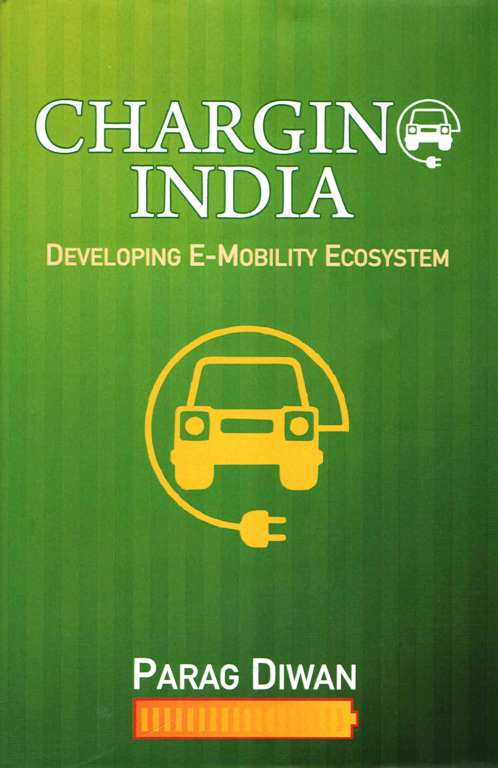news details |
|
|
| CHARGING INDIA: Developing E-Mobility Ecosystem | | |  Dr. Parag Diwan Dr. Parag Diwan
Reviewed by Col Anil Bhat, VSM (Retd)
ALL ABOUT THE ENVIRONMENT-FRIENDLY
VEHICLE OF THE FUTURE
This book explores various facets of the transition to e-mobility, looking at a macro level of India’s quest for 100% electric mobility. It also delves into best practices regarding how countries across the globe transitioned to electric vehicles.
The book provides a one-stop source for information about the policies that inform readers about the limitations and opportunities that currently exist in the country. While many of these policy interventions – both at central and state level – have concentrated primarily on the manufacturing side of electric vehicles, it is pivotal that policy frameworks should now turn their focus to EV services and auxiliary services to garner interests amongst consumers to adopt electric vehicles.
While government regulations and policies aid the ecosystem development, innovations in subsystems and components of EVs is a crucial aspect for the advancement of technology in the sector. The book also provides focused inputs on different parts of an electric vehicle – starting with the battery, analogous with the heart in a human body. The dedicated chapter explores the history of battery technology, celebrates major milestones in battery development before exploring the role, opportunities, and considerations of batteries for EV application. The book focuses on different types of battery technologies and chemistry available and in use for readers to understand the nuances between battery types.
What makes this chapter essential is to understand the nuances of customer adoption and usage. Many consumers are still apprehensive about the number of kilometres they can drive on a single charge of these vehicles – giving birth to the term most associated with electric vehicles, ‘range anxiety’. Studies show that while cars spend most of the time parked, the issue of range anxiety is currently that affects the adoption of electric vehicles.
The book is written in a way that readers do not have to necessarily have prior knowledge of automobile design and mechanical energy but should be interested about knowing the role of each part and how they contribute to the effectiveness of the electric vehicle. The chapter dedicated to the components of the EV also talks about the electric and electronic modules involved and how they play an important role in increasing the efficiency of the vehicle. Electric vehicles have integrated some technologies like the battery management system (an upgrade on the current fuel management system) and regenerative braking that puts them at an operational and cost advantage to conventional gasoline-based vehicles.
By now, the readers would have a fair idea of the structure of EVs and the book then transitions to understanding the fuel type – in this case, electricity – for EVs to run on. The chapter introduces different charger types that are being used across the world, with information of the evolution of the chargers and how countries have institutionalized the charger type based on the current specifications of the region. The chapter also explain about different charging infrastructure technologies that are being experimented globally, with a focus on inductive charging and the potential it holds for influencing trips patterns.
With a strong foundation of the charger types, the book builds from there to understand the factors that affect the adoption of electric vehicles – the electric charging infrastructure. The book paints a picture of the global best practices of establishing a city, state, and country wide charging infrastructure, and narrowing it down to examples from Asia to understand the contextual aspect of the development. A specific section of the book is also a brief about India examining the opportunities and limitations of setting up the infrastructure and the impact of increased demand of energy on the power grid.
The last two chapters delve deep into the major challenges of EV policies in India and how different industry vehicles need to adapt to this transition and comparing it to the global scenario of EVs. These chapters also discuss the different kind of business models – manufacturing, service, and disposal – that have come up recently across the globe and how India, at this moment, is perfectly placed to deploy these innovations across cities.
The book intends to be a collection of fundamental and design principles of an Electric Vehicle where readers can learn the basics, methods, practices, trends, and future expectations of the EVs and as such, may inspire many to develop a keen interest in the Electric/Hybrid Vehicle technologies and be more participative in this transition.
Parag Diwan is a technologist and an energy sector academic. The book is useful not only for those involved in this field, but also for students, entrepreneurs, armed and security forces and can also serve as an academic textbook for the university students who are taking a foundation course in electrical vehicles. |
|
|
|
|
|
|
|
|
|
|
|
|
| |
| |
|
|
|
|
 |
|
|
